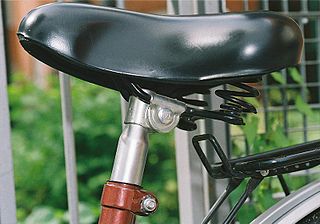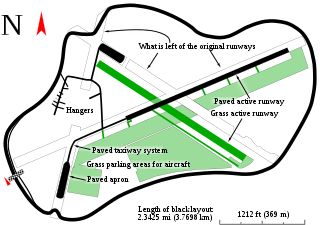
The headset is the set of components on a bicycle that provides a rotatable interface between the bicycle fork and the head tube of a bicycle frame. The tube through which the steerer of the fork passes is called the head tube. A typical headset consists of two cups that are pressed into the top and bottom of the headtube. Inside the two cups are bearings which provide a low friction contact between the bearing cup and the steerer.

A bicycle seatpost, seatpin, saddlepole, saddle pillar, or saddle pin is a tube that extends upwards from the bicycle frame to the saddle. The amount that it extends out of the frame can usually be adjusted, and there is usually a mark that indicates the minimum insertion. Seatposts can be made of steel, aluminum, titanium, carbon fiber, or aluminum wrapped in carbon fiber.

Flatland is a freestyle BMX riding style performed on smooth flat surfaces that do not include any ramps, jumps, or grindrails. It is sometimes described as a form of artistic cycling with a blend of breakdancing.

The Yamaha FJR1300A and FJR1300AE/AS are sport touring motorcycles made by Yamaha Motor Company. Both models have a 1,298 cc inline-four engine. The AE/AS model has an electronically controlled clutch and gear shifting system called YCC-S. The clutch and transmissions of the AE/AS models are identical to that of the standard FJR model.

The Thruxton Circuit is a 2.356 mi (3.792 km) motor-racing circuit located near the village of Thruxton in Hampshire, England, United Kingdom, about 30 miles north of Southampton.

The Harley-Davidson Sportster is a line of motorcycles produced continuously since 1957 by Harley-Davidson. Sportster models are designated in Harley-Davidson's product code by beginning with "XL". In 1952, the predecessors to the Sportster, the Model K Sport and Sport Solo motorcycles, were introduced. These models K, KK, KH, and KHK of 1952 to 1956 had a sidevalve engine, whereas the later XL Sportster models use an overhead valve engine. The first Sportster in 1957 had many of the same details of the KH including the frame, fenders, large gas tank and front suspension.

A bicycle saddle, often called a bicycle seat, is one of five contact points on an upright bicycle, the others being the two pedals and the two handles on the handlebars. The bicycle saddle has been known as such since the bicycle evolved from the draisine, a forerunner of the bicycle. It performs a similar role as a horse's saddle, not bearing all the weight of the rider as the other contact points also take some of the load.

A motorcycle fork connects a motorcycle's front wheel and axle to its frame, typically via a yoke, also known as a triple clamp, which consists of an upper yoke joined to a lower yoke via a steering stem, a shaft that runs through the steering head, creating the steering axis. Most forks incorporate the front suspension and front brake, and allow the front wheel to rotate about the steering axis so that the bike may be steered. Most handlebars attach to the top clamp in various ways, while clip-on handlebars clamp to the fork tubes, either just above or just below the upper triple clamp.

Bicycle and motorcycle geometry is the collection of key measurements that define a particular bike configuration. Primary among these are wheelbase, steering axis angle, fork offset, and trail. These parameters have a major influence on how a bike handles.

The Kawasaki Ninja ZX-9R is a motorcycle in the Ninja sport bike series from Japanese manufacturer Kawasaki, produced from 1994 until 2003. There were five model incarnations across two basic designs.

The stem is the component on a bicycle that connects the handlebars to the steerer tube of the bicycle fork. Sometimes called a goose neck, a stem's design belongs to either a quill or threadless system, and each system is compatible with respective headset and fork designs:

A bicycle handlebar is the steering control for bicycles. It is the equivalent of a tiller for vehicles and vessels, as it is most often directly mechanically linked to a pivoting front wheel via a stem which in turn attaches it to the fork. Besides steering, handlebars also often support a portion of the rider's weight, depending on their riding position, and provide a convenient mounting place for brake levers, shift levers, cyclocomputers, bells, etc.

Originally designed in 1966 by Leonard R Jordan Jr, the steering damper or steering stabiliser is a damping device designed to inhibit an undesirable, uncontrolled movement or oscillation of a vehicle steering mechanism, a phenomenon known in motorcycling as the death wobble. The stabilizer absorbs unwanted energy in the side to side motion allowing the forks and shocks to work properly. Many things can cause a motorcycle chassis to get upset such as slamming on brakes, rough road, and lastly improper setup. An upset chassis can be a great deal of danger for the rider often times resulting in a crash. A steering stabilizer slows those movements down resulting in the rider feeling more comfortable on the motorcycle.

A motorcycle fairing is a shell placed over the frame of a motorcycle, especially racing motorcycles and sport bikes, to deflect wind and reduce air drag. The secondary functions are the protection of the rider from airborne hazards and wind-induced hypothermia and of the engine components in the case of an accident. A motorcycle windshield will usually be integrated into the design of the fairing.

BMW S1000RR is a race oriented sport bike initially made by BMW Motorrad to compete in the 2009 Superbike World Championship, that is now in commercial production. It was introduced in Munich in April 2008, and is powered by a 999 cc (61.0 cu in) four-cylinder engine redlined at 14,200 rpm.

The Velocette Venom was a 499 cc single-cylinder four-stroke British motorcycle made by Velocette at Hall Green in Birmingham. A total of 5,721 machines were produced between 1955 and 1970.

The Speedmaster is a Triumph cruiser motorcycle designed and built in Hinckley, Leicestershire. Launched in 2002 with a 790 cc (48 cu in) twin-cylinder engine, the displacement was increased to 865 cc (52.8 cu in) in 2005, upgraded to fuel injection in 2008, and in 2018 the displacement was increased to 1,200 cc (73 cu in).

A wheelie bike, also called a dragster, muscle bike, high-riser, spyder bike or banana bike, is a type of stylized children's bicycle designed in the 1960s to resemble a chopper motorcycle and characterized by ape hanger handlebars, a banana seat with sissy bar, and small wheels. Notable examples include the Schwinn Sting-Ray and Krate lines and the Raleigh Chopper line. Other notable manufacturers and retailers that offered models include AMF, CCM, Columbia, Huffy, Iverson, J. C. Penney, Malvern Star, Monark, Murray, Ross, Sears, and Vindec.























